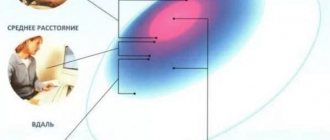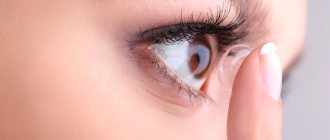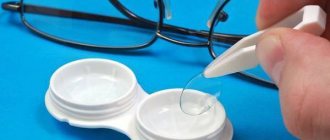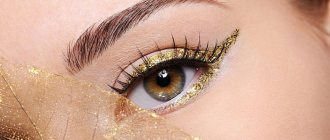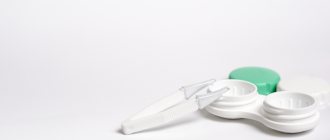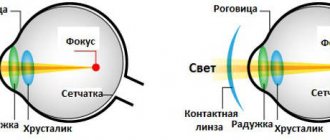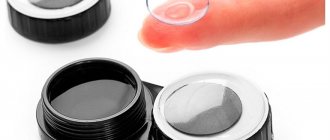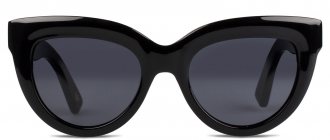Who is suitable for continuous wear lenses?
- For travelers and people who are often on the move.
- For those who suffer from myopia, farsightedness and astigmatism.
- People who have undergone surgery on the cornea of the eye. In their case, the lenses are used as a bandage.
- For young children who do not yet know how to remove and put on lenses.
- For older people and representatives of a number of professions whose work shift lasts a day or more.
- Young people visiting nightclubs, etc.
When traveling, hiking or business trips, it is not always possible to remove lenses: sometimes conditions simply do not allow it.
Continuous wear lenses should not be confused with extended wear lenses. The permanent mode involves keeping the lenses on the eyes for thirty days. That is, they are not removed at all for a month. And extended-wear lenses mean their use for up to six days in a row and no more. But it should be noted that continuous wear lenses should be removed occasionally at night to clean them and give your eyes a rest.
Air Optix Night&Day
Terms of use
They do not require any special care, since they can be easily worn for a month, without even taking them off at night. You just need to open the package and put on new lenses, and after a month, simply remove and throw them away. Don't forget that before you start using a new pair, you need to rest your eyes for at least one day.
Such contact optics can also be used in daytime or flexible mode, shooting at night. During this time, it must be placed in a container with a special disinfectant solution that removes all protein deposits. At the end of the month, it is imperative to replace these optical products with new ones.
Reasons for wearing lenses for long periods of time
Long-term wearing of lenses is very convenient for users. These small devices are almost invisible to the eye (they can only be seen with a careful examination of the eye). Vision with lenses improves, just like with glasses, but the former are much more convenient. Now you don’t need to turn your head to look down or up (as you have to do with glasses), you just need to squint your eyes. The lenses will not fall out of your eyes, even if you decide to take a wild ride on a cool attraction. They will not fog up when there is a sudden change in temperature.
There will always be people for whom continuous lens wearing is in demand for certain reasons. These include representatives of certain professions, for example, drivers carrying cargo or passengers over long distances. While they are on the move, removing and caring for the lenses is not easy, and it is dangerous due to the high probability of infection. Those who spend a lot of time on the road or on business trips also prefer contact lenses for long-term wear.
There is a category of people who wear lenses continuously only because it is convenient for them. They do not want to bother with lenses, take them off every day, care for them, and then put them on again. It is easier for such consumers to go once a month to a specialist who will remove the old lenses from their eyes and put on new ones. Well, such a position has a right to exist.
Specifics and features
Long-term wear contact lenses are most often prescribed to patients with diseases such as hypermetropia and myopia. These are soft ophthalmic contact devices made of hydrogel or silicone hydrogel. They can be completely transparent, or have a color tint that either emphasizes the patient’s natural eye color or radically changes it.
If we talk specifically about quarterly contact lenses, it is not difficult to guess that their service life, subject to all operating rules, is no more than 90 days. Next, you need to replace the pair with a new one. In addition, it is highly undesirable to sleep in such corrective devices, since they have low gas permeability. The normal daily use of this type of contact lens is no more than eight hours. Next, you need to give your eyes a rest.
The specificity of using such products is that once a month you will have to carry out deep cleaning. Otherwise, you risk getting an eye infection.
It is important to understand that if the period of use has expired, under no circumstances should you continue to use these products, even if they look like new in appearance. It's simply dangerous to your health.
Who is it suitable for?
Optometrists do not recommend extended-wear contact lenses to everyone. For people who start working night shifts, often travel and have vision problems, such optics are a good way out of the situation.
These devices should be worn by those who suffer from myopia or farsightedness. Lenses help:
- get rid of amblyopia;
- restore binocular vision;
- normalize refraction.
For people who have very poor vision and often get up at night, this type of optics is suitable. It is used by soldiers and officers, who are often involved in training camps, participating in hostilities, and tourists who spend all their free time on wheels.
A reliable and inexpensive medicine for the treatment of bacterial conjunctivitis is Levofloxacin eye drops.
Optima FW
An operation to form an artificial hole in the inner corner of the cornea to reduce intraocular pressure - laser basal iridectomy.
Continuous wear contact lenses - types
So, long-term wear lenses: which ones to choose?
Hydrogel
The main component in the composition is water, which acts as a conductor of oxygen to the cornea.
This type is comfortable and easy to wear. Another advantage is its resistance to protein deposits, which reduces the cost of purchasing care products for contact products, and also minimizes the occurrence of allergic reactions.
Attention! However, a significant drawback of this material is the evaporation of water from the surface of the product. This leads to dryness and lack of oxygen supply. This manifests itself in dryness and discomfort in the eyes and can cause consequences and complications
Continuous wear contact lenses of this type are not recommended to be worn more than 8-12 hours a day
This manifests itself in dryness and discomfort in the eyes and can cause consequences and complications. Continuous wear contact lenses of this type are not recommended to be worn more than 8-12 hours a day.
Silicone hydrogel
They represent the most successful combination of two materials. Compared to hydrogel models, they have high oxygen permeability, improved comfort and wear resistance of the surface, as well as low dehydration - loss of water over time.
They have a stronger resistance to protein deposits. Another advantage is the ability to wear them around the clock, which is important in cases where it is not possible to take them off before going to bed (for example, on a business trip, when traveling at night on a bus or train, and so on).
Important! The disadvantage of this type is the susceptibility to lipid deposits due to the silicone included in the composition. This leads to a deterioration in the wettability of the surface with tears and increased friction of the eye.
Rigid gas permeable
Made from silicone-based materials.
This provides the product with high oxygen permeability, much higher than in soft analogues (hydrogel and silicone hydrogel models). Due to the density of the material, this type retains its shape better and has increased wear resistance. Due to the absence of water, hard lenses do not dry out in the wind or in a dry room, so the use of moisturizing drops is not required.
Important! The most important advantage is the use of this type for vision correction for diseases such as astigmatism, age-related farsightedness and other ailments for which wearing soft models is impossible.
Among the disadvantages, it is worth highlighting the long adaptation period at the beginning of wearing, as well as difficulties in selection, since the model must ideally fit the cornea of the eye.
Risks associated with continuous lens wear
Many eye doctors are against long-term wearing of contact lenses. They consider this very dangerous and give several arguments to defend their point of view:
- During wear, contamination in the form of protein and lipid deposits forms on the lens. The longer a consumer wears lenses that require replacement, the higher the risk of infection. If the lenses are intended to be worn for a period of 1 month, then they should be replaced after the specified period, even if they were worn only a few times.
- Over time, irreversible changes occur in the material from which the lens is made. And this is dangerous for the eyes and the body as a whole.
The cornea of the eye, covered with a contact lens for a long time, suffers from hypoxia (chronic lack of oxygen), which can lead to irreversible consequences and deterioration of vision. Different lens materials have different degrees of oxygen permeability, so acceptable wearing conditions are recommended for each type of lens.
The most dangerous complication that long-term wearing of lenses can lead to is microbial keratitis. Scientists conducted research for 15-20 years, analyzing the prevalence of this complication among wearers of different types of lenses.
It turned out that those who wear soft lenses during the day, who take them off before going to bed and put on clean or new lenses in the morning, are at the lowest risk of developing microbial keratitis. Most often, this disease occurred in people who used continuous wear contact lenses.
Thus, long-term wear contact lenses are the main cause of microbial keratitis. Research results have proven that even modern silicone hydrogel extended-wear lenses, approved by the American organization that controls food, cosmetics and medical products FDA, do not minimize the risk of developing such a complication.
The conclusions are:
- It is better to use lenses for daily wear.
- Use long-term wear lenses only in emergency situations.
- Under no circumstances should you ignore the timing of using and wearing lenses.
Types of lenses
Continuous wearing time depends on the material used.
The following types of CL are distinguished:
- hydrogel;
- silicone hydrogel;
- rigid gas permeable.
The use of hydrogel prevents the development of allergic reactions and protein deposition. The disadvantage of this type is low breathability and quick drying. Therefore, the maximum wearing period is 8-12 hours a day, without the risk of developing corneal hypoxia, dryness and eye discomfort.
Silicone hydrogel contact lenses have been improved: they have a higher supply of oxygen to the eye, and moisture is better retained on the surface of the lens. Advantages: 24-hour wear, resistance to protein deposits. Disadvantage - due to silicone, lipids are deposited on the film, which are cleaned and removed with a special solution.
The wearing time for silicone hydrogel optics is from 1 day to 1-3 months, it is indicated on the packaging. It is recommended to periodically remove it at night and treat it with liquid.
Rigid gas-permeable contact lenses provide the highest air access to the cornea and are made of durable silicone-based materials. They have increased wear resistance, retain their shape, and can be used for various diseases (astigmatism, presbyopia).
Long term lenses
They are ideal for travel, night work, day work. Suitable for people who forget or do not want to constantly remove products at night.
They are presented in the following types:
- two weeks;
- period;
- three months;
- six months.
These deadlines are maximum. They are indicated on the lens packaging. Depends on the material, technology, additional properties. It is recommended to take breaks. Periodically remove lenses at night to rest your eyes and clean the products. Two-week lenses are used for increased sensitivity. Well-known companies are Johnson&Johnson, Alcon, Bausch+Lomb.
No less popular are products for 30 days of wear, 3 months. They are the most economical.
CLs for 6 months are practically not issued for a number of reasons. The most significant is insufficient provision of comfort and hygiene of the organ of vision. Infectious and inflammatory eye diseases – blepharitis, conjunctivitis – may occur. Serious pathologies of the cornea are not uncommon, including loss of vision if operating instructions are not followed.
When using continuous wear contact lenses, follow 2 rules:
- Change the contact lens before the end of the wearing period. This will prevent the development of complications, inflammation, and infections.
- Periodically remove your lenses at night by placing them in a special cleaning solution.
Pay attention to the best long-term contact lenses.
The disadvantage of the Biofinity (USA) brand is its high cost. Silicone hydrogel is used for production, eliminating the use of special moisturizing agents. The maximum time of continuous use is 7 days, and you can wear it for a week without taking it off, or during the day and rest your eyes at night.
The advantage of the model is its high level of breathability, which ensures comfortable use without the development of complications. Oxygen continuously flows to the cornea of the eye, preventing the development of hypoxia. In addition to correcting farsightedness and myopia, lenses from this concern correct astigmatism and age-related presbyopia.
British optical products Maxima 55 are of the hydrogel type, partially protecting the eyes from ultraviolet rays. They are opaque, colored “films” for quick searching and easy putting on.
Alcon (Switzerland) produces lenses with high breathability. They are treated with a special compound that protects the product from proteins and fats. This is a great choice for sensitive eyes.
Pay attention to the AirOptix Aqua model, which can be worn day and night for a month. It is also made of silicone hydrogel. The shape of the lens resembles the biosphere. This provides a good, undistorted picture, excellent fit of the “film” on the eye, and comfortable wearing.
Other popular optical products:
- Acuvue Oasys with Hydraclear plus - can be worn continuously for two weeks or during the day, the material provides additional hydration and good oxygen access to the cornea. They are comfortable in rooms where air conditioners and heating sources operate. The difference between the lenses is a high degree of protection from UV waves, tinting and an inversion indicator for easy putting on.
- Pure Vision 2 HD – designed for monthly flexible or continuous use, especially suitable for computer work, in artificial lighting conditions and for drivers. They provide high clarity of vision without distortion or glare.
- The Acuvue 2 model is designed for weekly use. It also has a blue tint and an inversion indicator, protects against UV radiation and lipid deposits.
How to choose
Before purchasing extended wear contact lenses, visit your ophthalmologist. He will assess the condition of the visual apparatus, characteristics (diopters, intraocular pressure, corneal curvature).
Depending on the disease, the CL material is selected.
The choice is influenced by lifestyle (daytime, nighttime, active, working in smoky rooms with air conditioners or heating sources on, monitors). For an exclusively daytime lifestyle, CLs made of hydrogel or silicone hydrogel are suitable. The second ones can be left on at night.
If the work involves irritating factors, pay attention to the additional properties of some lenses: high degree of moisture, protection from UV rays
It is important to choose the best, proven brands: Johnson & Johnson, Alcon, Bausch & Lomb
It is important to choose the best, proven brands: Johnson & Johnson, Alcon, Bausch & Lomb
Useful video
It describes the types of products.
Continuous wear lenses are ideal for active people. With the right choice and careful hygiene, contact lenses are safe.
Author's rating
Author of the article
Alexandrova O.M.
Articles written
2029
about the author
Was the article helpful?
Rate the material on a five-point scale!
If you have any questions or want to share your opinion or experience, write a comment below.
Long-term wear contact lenses - what are they?
This concept means the ability to stay in the eyepieces for several weeks without requiring their replacement. Some models, according to manufacturers, can be safely left overnight.
There are several varieties of this type of optics depending on the duration of use:
- Two weeks. Ideal for people suffering from eye hypersensitivity. They are “used” without replacement for fourteen days. A popular product in this category is Acuvue Oasys;
- Period. A common model, available in various variations. Lenses differ in the amount of moisture in the composition, level of permeability, etc. Alcon and Maxima Optics have a large selection of products;
- For three months. An excellent option for those who do not like to overpay for optics and prefer to save their family budget. A similar eyepiece can be found in the collection of the Bausch&Lomb Corporation;
- For half a year. They were wildly popular a couple of years ago, but today they are very difficult to find in stores. Manufacturers are gradually abandoning their production, since the product is not able to provide the required level of hygiene for the organ of vision. Try to find a suitable model in the CooperVision brand range.
| Before purchasing any type of optics, visit an ophthalmologist. After assessing the condition of your eyes, he will select the optimal type of eyepieces and write an appropriate prescription. |
I don’t see other candidates: which lenses are better to choose for long-term wear
We asked an ophthalmologist about how to choose good lenses and found the cheapest models
How We Did It Contact lenses were first described by Leonardo da Vinci in the early 16th century. At the end of the 19th century, German glassblower F. Müller invented a glass lens that could be placed directly in the patient's eye. In the mid-20th century, there were attempts to use plastic to make lenses, but even with this material, the lenses continued to be uncomfortable. The first soft contact lenses appeared in 1960, and a decade later the Bausch & Lomb company launched their production and made them available to patients. Since then, many new lens materials have been invented and new surface designs have been developed. And most importantly: it became possible to wear them without taking them off for a long time without damaging the eyes.
In our rating, contact lenses are ranked according to the minimum price for a package of 6 lenses for a month's wear.
And we asked Svetlana Gavrilova, an ophthalmologist at the Lens optics salon, .
What types of soft lenses are there and which are the most popular among customers? Lenses are divided according to wear period. The most hygienic option is daily lenses. But such wearing most often requires high financial costs, so most buyers choose contact lenses with a wear period of two weeks or more. Soft contact lenses are: • hydrogel; • silicone hydrogel. If we compare these materials, silicone hydrogels are the best option for long-term, continuous wear. This is because the level of oxygen permeability here is very high. For hydrogel lenses it is several times lower, so these contact lenses cannot be worn for a long time - no more than 6 hours.
Is it easy to switch from glasses to contact lenses? Compared to glasses, the lens provides a wider view because it follows all eye movements. With contact lenses you can see better and more clearly, since when using them there is no distance that remains between the spectacle lens and the cornea of the eye. However, there are also disadvantages. The lens does not jump into the eye on its own; it needs to be placed. This is a kind of psychological barrier, and sometimes it is difficult for people to overcome it. For some people, lenses require gradual adjustment. It is recommended to start wearing them 3-4 hours a day, and then gradually increase the duration of wearing them by 1 hour. Moreover, finding the right lenses is not an easy task as you need to take into account all the factors when choosing lenses. This includes the required wearing time, the nature of the work, the shape of the eyes, the shape of the eyelids, the composition of the tear film, what ophthalmic agents are used, and so on. Lenses differ not only in materials, but also in optical power, curvature and other characteristics. When choosing contact lenses, it is very important to follow the recommendations of your doctor.
What are the worst mistakes you have seen in wearing lenses? Firstly, insufficient cleaning of the lenses . Many people neglect the mechanical cleaning of contact lenses, believing that it is not necessary. Secondly, violation of the lens wearing regime . Often, patients wear hydrogel contact lenses almost 24 hours a day - this should not be done under any circumstances, since they have a short wearing time. Well, the last mistake that some people make is over-wearing their lenses . Some people may wear daily contact lenses until they break. But they can break, for example, in a month. This attitude leads to inflammatory eye diseases, causes problems with blood vessels, and swelling of the cornea.
What criteria are most important when choosing lenses? As I already said, oxygen permeability . For our eyes, lenses are a foreign body that prevents the normal supply of oxygen from the external environment. Therefore, it is important that their material has high permeability. This characteristic is designated as Dk/t. The higher the indicator, the higher the oxygen permeability. The next indicator is moisture content . In silicone hydrogel lenses, the silicone is responsible. Moisture content is measured as a percentage. Without moisture, it is impossible to maintain eye health while wearing contact lenses. Lens refraction - written as a number with a '+' or '-' sign and refers to the optical power of the contact lens. Some manufacturers provide a very wide range of refractions, others a narrower one. And, of course, wearing mode . Because, despite the advantages of silicone hydrogel lenses, not all of them are suitable for extended (that is, continuous) wear. There is also such a thing as elastic modulus , the higher it is, the better the lens holds its shape, and the more convenient it is to put it on. The lower it is, the softer the lens, and the more comfortable it is for the eye. Here everyone determines their own option for themselves.
9. Alcon Air Optix Night & Day Aqua
Price: from 2600 to 3198 rubles Wearing mode: 1 month, possibly extended up to 30 days Oxygen transmission coefficient: 175 Dk/t Moisture content: 24% Refraction range: from −10.0D to +6.0D
This model is specially created for prolonged wear. It can be convenient for those who for some reason find it difficult to clean and change lenses, for example, for children or the elderly.
8. Bausch & Lomb Ultra
Price: from 2000 to 2480 rubles Wearing mode : 1 month, daily Oxygen permeability: 163 Dk/t Moisture content: 46% Refraction range: from −12.0D to +6.0D
These lenses are in great demand among us; many people find them very comfortable. This is due to high oxygen permeability and moisture content. But it is not recommended to wear them without taking them off.
7. Acuvue Oasys With Hydraclear Plus
Price: (x2) from 1980 to 3800 rubles Wearing mode: 2 weeks, possibly extended up to 7 days Oxygen permeability: 147 Dk/t content: 38% Refraction range: from −12.0D to +8.0D
These are two-week wear lenses. In general, the more often we change the lens, the better it is for the eyes. There is good oxygen permeability and a comfortable fit. These lenses have laser markings on them for correct insertion: you do not need to look closely to see if you are putting the lens on the right side.
6. Coopervision Biofinity
Price: from 1822 to 3400 rubles Wearing mode: 1 month, possibly extended up to 7 days and 6 nights Oxygen permeability: 160 Dk/t content: 48% Refraction range: from -0.5D to +8D
There is a high level of oxygen permeability and hydration. In addition, these lenses can be worn extended. Even after sleep, for many users they remain in place and do not move. This is a good option for those who do not want to change lenses every day.
5. Alcon Air Optix Aqua
Price: from 1430 to 2590 rubles Wearing mode: 1 month, possibly extended up to 6 days Oxygen permeability: 138 Dk/t content: 33% Refraction range: from −10.0D to +6.0D
This line has a very wide diopter range, and SmartShield technology is also used in production, which creates a protective layer of moisture. This makes the lens easier to clean and more comfortable to wear.
4. Alcon Air Optix Plus Hydroglide
Price: from 1613 to 2250 rubles Wearing mode: 1 month, possibly extended up to 6 days Moisture content: 33% Oxygen permeability: 138 Dk/t Refraction range: from −10.0D to +6.0D
In addition to SmartShield technology, this model also uses another one, HydraGlyde. It is aimed at reducing friction of the lens on the eye tissue, as well as longer-term hydration of the optics by retaining moisture on its surface. Thus, prolonged wearing becomes even more comfortable.
3. Bausch & Lomb Pure Vision
Price: from 1199 to 1600 rubles Wearing mode: 1 month, possibly extended up to 30 days Acid permeability: 112 Dk/t content: 36% Refraction range: from −12.0D to +6.0D
These lenses are “classics of the genre.” They are used as corsets because they hold their shape well, have good oxygen permeability and the possibility of prolonged use. They can protect the cornea in the postoperative period, if necessary. They are also very easy to handle, as they have a good fit and a high modulus of elasticity, and are easy to put on the cornea. Very convenient for training and initial wearing of lenses.
2. Adria O2O2
Price: from 1060 to 1300 rubles Wearing mode: 1 month, possibly extended up to 7 days and 6 nights Oxygen permeability: 100 Dk/t content: 45% Refraction range: from −9.5D to +8D
We purchased these lenses for sale not long ago, but they are already in demand. Probably due to the affordable price. But at the same time, the start of wearing is definitely good. They also have the option of extended wear.
1. Coopervision Clariti Elite
Price: from 1030 to 1400 rubles Wearing mode: 1 month, daily Oxygen permeability: 86 Dk/t Moisture content: 56% Refraction range: from −10.0D to +8.0D
Clariti Elite is an excellent transition option between hydrogel lenses and the new generation of silicone hydrogel lenses. The low modulus of elasticity of these lenses ensures comfortable wearing.
Today our rating came out like this, but tomorrow everything can change.
How to care for long-term wear lenses?
It is necessary to select a solution that will most accurately match the type of product.
Attention! Products in this category, in addition to mandatory compliance with the usual rules of care and storage, require additional measures to ensure disinfection, cleaning and moistening.
- Use enzyme cleaners from the first week of wearing contact lenses. Available in the form of tablets and drops. The principle of action is based on the breakdown of protein molecules deposited on the surface of the product. The effect is effective only if used regularly once a week.
- For dry eyes, use moisturizing solutions.
- Constantly monitor the condition of your eyes. If swelling and redness of the eye vessels appear, immediately consult an ophthalmologist.
- At the end of the wearing period, you must replace the lenses with new ones, even if you did not wear them daily.
- You can do makeup only after putting on lenses, and you can wash off decorative cosmetics only after removing them.
Popular brands
The most in demand are long-wearing optics, which are produced by Alcon, Bausch+Lomb, Maxima Optic, Cooper Vision.
Lenses under the Acuvue Oasys brand are manufactured from hydrogel by Jonson & Jonson. They are used for 14 days in two modes. Thanks to successful technology, the cornea receives oxygen and does not lose moisture. Optics are suitable for hypermetropia and myopia, and are great for those who sit at the computer for a long time.
Wearing lenses is comfortable, but sometimes in people with hypersensitivity they cause a burning sensation, a feeling of the presence of some object. The price of a package containing 6 pieces is 1049 rubles.
Complete restoration of visual acuity – pros and cons of laser vision correction.
Compliance with hygiene rules will help avoid the development of infectious diseases
In rare cases when worn:
- photophobia occurs;
- dry syndrome develops;
- eyes turn red.
A pack of 6 pieces sells for 769 rubles.
CIBA Vision is known for options that have a month of continuous use, do not accumulate plaque, are comfortable for the eyes, and moisturize the cornea well. A package of wonderful optics will cost 1,240 rubles.
Optima FW lenses, which are worn for 3 months, from Bausch+Lomb delight those who like to save money. The ultra-thin design is easy to put on, resistant to damage, does not accumulate protein plaque, has a smooth surface, and protects the conjunctiva from dehydration.
A low-traumatic method for restoring refraction is LASIK eye surgery.
Put on lenses only with clean, washed hands.
Effective therapy for bacterial infections of the visual organs - instructions for chloramphenicol eye drops.
Correct movement is the key to long service life of the product and its safety for eye health.
Dangers
Despite the excellent characteristics of monthly replacement lenses provided by manufacturers, you should be careful when wearing them at night. Not all patients are suitable for continuous mode
A lens, no matter how perfect it is, is a foreign object located in the eye. If you do not remove your lenses at night, oxygen deprivation of the cornea can catastrophically increase during sleep, which will cause its swelling.
Silicone hydrogel lenses often cause conjunctival fissures. They occur where the conjunctiva comes into contact with the edges of the lens.
Soft lenses absorb not only water, but also any moisture: tears, cosmetics. Deposits of mineral salts accumulate on their surface, pigment contaminants, protein and fat deposits are formed. This happens especially intensely at night, when the eye is not cleared by natural blinking.
In such an environment, infections can easily occur and damage the cornea.
In persons predisposed to allergies, the accumulation of protein material causes an immunological reaction on the inner surface of the upper eyelid - conjunctivitis of the giant papillae.
Therefore, wear lenses without removing them unless really necessary. It’s better to once again let your eyes “breathe” and keep the lens in a disinfectant solution.
Biofinity
Silicone hydrogel contact lenses from the American company Cooper Vision are intended for daily use for a period of one month or continuous use for 2 weeks.
Among the features of this model, it is worth highlighting the Aquaform manufacturing technology. The lenses belong to the third (currently last) generation. Due to this, CLs have very high oxygen permeability. The silicone part of the lens includes a new generation of material with a long chain of molecules, which allows oxygen to freely penetrate through the lens to the cornea.
In the line of Biofinity lenses, in addition to the usual models for correcting myopia and farsightedness, there are toric lenses for the correction of astigmatism and multifocal lenses for the correction of age-related farsightedness (presbyopia)
The material from which Biofinity is made is called Comfilcon A. It has unique natural wetting properties, due to which the lens does not require additional processing or the addition of special wetting agents.
Another advantage of this model is the low modulus of elasticity of the product, which allows it to be compared in terms of flexibility and elasticity (and, accordingly, wearing comfort) with hydrogel lenses. Thanks to the rounded edges and aspherical design, the CL provides a comfortable fit.
Main characteristics of Biofinity MCL:
Thanks to all the above features and characteristics, Biofinity lenses can be worn safely and comfortably continuously for 2 weeks.
How to care?
It is important to choose a suitable solution for storing “records”. Remember that optics additionally need to be cleaned and disinfected
Follow these simple recommendations to avoid complications with your vision, and to make wearing eyepieces a pleasure:
- From the first week, use enzyme cleansing solutions. To prepare them, dilute one tablet in a glass of water. Enzymes break down protein molecules that accumulate on the surface of the lenses. Carry out a similar cleansing every seven days;
- If your eyes are dry, purchase moisturizing drops that mimic human tears;
- If swelling or redness occurs, contact your ophthalmologist immediately;
- Even if you did not use the optics every day, after the expiration date, recycle it;
- Wash off your makeup after removing the “plates” to prevent product particles from getting onto the surface.
Following simple rules will relieve eye health problems.
Safety when using colored lenses
Some, however, do not trust colored lenses, fearing irritation or allergies after exposure of the dye to the eye tissue. Of course, there is a danger of irritation from contact lenses, but it is no greater than that from wearing regular lenses. The bottom line is that the dye is usually applied to the surface of the lens, or even between the layers of the product, so the dye does not touch the eye tissue in any way. In addition, modern lenses are made from innovative materials that allow oxygen to pass through to the eye and prevent the eye membrane from drying out. These materials are completely hypoallergenic, do not cause any unpleasant reactions, do not rub the eye shell and do not damage the sclera or iris.
Colored lenses, like regular ones, are divided into several types according to the duration of wear. There are those that can be worn only during the daytime with a mandatory break at night, and there are those for continuous wear for up to 1 month. Also, colored lenses are soft and hard. Hard ones are made from more reliable material, so they can usually last up to 2 years. Experts recommend using soft lenses from 3 months to a year.
To prevent the use of colored lenses from causing discomfort and unpleasant consequences, it is advisable to consult an ophthalmologist before purchasing. He will advise on all issues of colored lenses and tell you which ones are best to purchase, taking into account the individual characteristics of your eyes.
Advantages and disadvantages of permanent wear lenses
People who prefer multi-day wear lenses save a lot of time caring for such optics. They easily go on business trips, to conferences, and competitions. Vision does not deteriorate after wearing it, since oxygen enters the cornea. The material from which such lenses are made is safe for the eyes.
They can be used by people with farsightedness (+6), with myopia (–12 diopters), with reduced accommodation. The advantage of such optics is the huge selection of models.
Can be worn continuously without removing for up to 3 months
What to do to make it last for a short time
However, if you do not care for your lenses well, you ignore the hygiene rules:
- The surface will become covered with plaque and deposits, which lead to allergies and eye hypersensitivity.
- The cornea is damaged if calcium salts accumulate on the optical apparatus.
- Fungi form and multiply.
And for a long time
When wearing such lenses, an infection can get into the conjunctiva, and this can lead to inflammation of the cornea, deterioration of vision, and even complete loss of vision. To avoid unpleasant phenomena and complications:
- Read the instructions and do not ignore the recommendations of the ophthalmologist.
- They try not to be in smoky or smoky rooms.
- Remove lenses at night before swimming and do not touch them with unwashed hands.
We must not forget about the expiration date. Read the information on the packaging carefully.
The model can be worn without removing for 1 month
A disease that prevents vision at dusk and in low light is night blindness.
Long-term wear contact lenses for eyes: what are they?
The lenses can be worn without removing for a month due to the fact that they contain special substances that moisturize the cornea.
Important! There are two modes of wearing such products: daytime and flexible, and ophthalmologists recommend using the second. With flexible mode, vision correction devices can be left on or removed at night
These CLs are comfortable to wear and, due to their material, they rarely cause side effects. If long-term wear lenses are used in flexible or daytime mode, they are stored in a special disinfectant solution. When they are not removed for a month, there is no need to use such a product.
Photo 1. For storage, a continuous wear contact lens is lowered with tweezers into a container with a disinfectant solution.
To whom are they assigned?
There are people who resort to continuous wearing mode out of necessity. These vision correction products are prescribed to people whose profession involves business trips and traveling. They are used by those who love to travel.
An ophthalmologist recommends products to patients who have undergone corneal surgery and have the following diseases:
- astigmatism;
- myopia;
- farsightedness.
Advantages of products for long-term use
When comparing long-term contact lenses with other vision correction devices, it is worth highlighting their low cost.
The positive aspects include:
- long period of use;
- providing clear images regardless of the time of day;
- infrequent replacement;
- variety of models.
Continuous wear lenses, which do not need to be removed, are made from modern safe materials that allow oxygen to pass through well, so the eye tissues can breathe. Thanks to the soft structure, comfortable conditions are created for the visual organs, and the cornea is not injured.
In CLs, the quality of vision remains very high throughout their use. Using these products you can save time because there is no need to put them on and take them off every day. It is noted that correction means of this kind can be used for almost any pathology and visual acuity.
Negative sides
One of the disadvantages of these products is that they gradually become less transparent as deposits accumulate on them. Constant wearing can lead to blurred vision and a feeling of a foreign body in the eye. They are not recommended for people who have dry eyes.
Specifics of wearing contact lenses
New generation lenses are very helpful for people with poor vision, because they allow them to work, play sports, travel, enjoying the brightness and contrast of images and color rendition. With the advent of contact optics made of silicone hydrogel material, which combines all the advantages of silicone, which allows oxygen to easily pass to the cornea and hydrogel, the number of users experiencing unpleasant symptoms has decreased. Now those who have chosen contact lenses as the main method of vision correction do not feel dry or burning eyes, even if they work intensively with digital technology and are exposed to visual stress on a daily basis.
The only disadvantage of contact lenses, which are significantly superior to glasses in all respects, is the care of the optics. But this problem was successfully solved by one-day optical products that do not need to be cleaned and disinfected. But what about those who do not have the opportunity to remove their lenses in a timely manner in the evening, who are on a trip, or who work at night? For such consumers, manufacturers produce lenses with prolonged and continuous wear.
What are the specifics of the wearing mode? Why can some lenses be worn for a long time, while others cannot? Let's look at each mode:
- daytime wear - such models are designed for use during the day, for 10-12 hours, during this period they retain the moisture content characteristics declared by the manufacturer, and then the level of moisture may decrease, which causes significant discomfort to the user;
- flexible mode - daytime sleep in lenses is possible, night sleep is undesirable, but allowed (1-2 nights in a row);
- prolonged mode - you can wear optical products without removing them for one week;
- continuous wearing - with permission from an ophthalmologist, such models can be worn for 30 days, without interruption.
The best option for daytime wear are one-day models that do not require disinfection or cleaning of deposits. Contact optics, recommended for continuous or prolonged wear, have many advantages, since they remove many restrictions and allow you to forget about poor vision for a while.
Peculiarities
For lenses to be comfortable and safe, they must allow oxygen to pass through and retain moisture. Monthly lenses are made from silicone hydrogel, a material consisting of two layers.
The hydrogel provides natural hydration to the cornea, and silicone allows oxygen to penetrate the eye tissue, supplying it with the necessary nutrition. To prevent the accumulation of protein deposits, the surface of the lenses is plasma polished.
It is assumed that you can sleep in them without fear of getting up in the morning with a “blurred” look and a “feeling of sand” in the eyes.
Provided wearing modes: daily and prolonged. In the first case, the lenses are worn during the day, and at night they are removed, disinfected with a special solution and placed in a container. The second method (prolonged) - they are worn around the clock, even during sleep, but once every 6 days they are removed, cleaned and the eyes are allowed to “rest”. In both cases, contact correction devices must be replaced after a maximum of 30 days.
Who has been wearing contact lenses for many years, take a moment?
I wore lenses from 2000 to 2011. I am considered, by doctors’ standards, to be a mastodon, since (according to our local and Volgograd professors. Yeah. I consulted) the maximum period for wearing lenses is 10 years (they haven’t seen any more among patients without complications). Why am I writing in the past tense? 11 years after I started wearing lenses, my eyes simply began to reject them. All. I always wore the most expensive and high-quality ones. They brought them to me on order through the hospital (i.e., no purchases at optical stores or terminals), I used all the liquids regularly, and did not break any rules. the limit has simply come. The doctor said so after the examination. By the way, there were no consequences and there are no limits (I was examined less than a month ago). After six months of wearing glasses (after being forced to give up contact lenses), she freaked out and underwent surgery in December 2011 and January 2012 (the interval established between PPLKS and LASIK). one.
9 minutes ago, Nikita79 said:
I’ve been wearing them for probably 25 years, since the first “hard” ones, I wore them incorrectly as a teenager (I didn’t take them off for days, I slept in them, etc.)I recently switched to one-day wear, before wearing it monthly or even quarterly, I only took it off at night.
I don’t notice any consequences and I plan to wear them until the last minute, because glasses have been psychologically uncomfortable since childhood.
I asked about the operation at the center last year - the doctor honestly said, what’s the point? It should be done at a young age, but now for a year or two and after the operation I will have to wear plus glasses, since I will be able to see in the distance, but it will worsen up close
and he’s right - I’m already noticing that in the lenses close behind the phone or laptop it’s already starting to float, and my eyes are straining
those. if it’s good close up, then I can’t see it in the distance; if it’s good in the distance, then it’s hard up close - standard age-related changes
so I’ll wear the lenses without surgery, as long as they wear without problems, and then we’ll see
your doctor, apparently, does not realize the difference between plus diopters of the age range up to +2.5-3 and severe minus myopia -10, for example. I won’t be upset one bit about wearing plus-size thin eyes in a beautiful frame for reading and computer use. but with a shudder I remember my -10 and the corresponding thickness of the glasses, since no super-cool Japanese polymers even in my time could save me from such a minus (the glass thickness of a lens with -10 cannot be made like a parchment sheet so that it would be comfortable in glasses and not suffer from pain in the nose and ears due to their severity, plus this wonderful spectacle bonus in the form of lack of lateral vision).
How to make wearing lenses more comfortable
To avoid discomfort and harm to your health when using optics, follow these simple rules:
- To facilitate the process of removing the “plates,” first use moisturizing drops;
- After the expiration date, immediately discard the product;
- Do not purchase eye drops without first consulting your doctor;
- You need to apply makeup after putting on the lenses;
- Do not allow particles of cosmetics to get on the surface of the eyepieces;
- Buy product care products on the recommendation of a doctor, and not on the advice of your girlfriends.
| Even the best long-term contact lenses will cause discomfort if you do not wear them properly. |
Which contact lenses for long-term wear are best to choose?
In fact, it is difficult, or rather even impossible, to say which models are better, since everything is individual. Today, several European brands of different price segments occupy leading positions. Some look more impressive, others have a special shape, reducing the level of possible discomfort. More expensive ones have increased gas permeability. However, only a doctor during the examination process can say with exact certainty which ones are right for you.
Like glasses, contact lenses must be selected individually. In some cases it is necessary to order a custom pair.
Selection tips
contact a specialist
After this, you can purchase the type of lenses that suits you yourself. When choosing, you should focus primarily on the name of the manufacturer. Since the technologies used in the production of such models, aimed at long-term wearing, are more advanced, it is worth focusing on companies that have proven themselves in the market, for example, Johnson & Johnson or Vision Novartis.
The doctor may prescribe a re-examination for you after you have started wearing lenses, because you need to adapt to them - and it is advisable to supervise the stages of this adaptation in order to avoid potential problems in the future.
Please note that the price of such lenses, due to their features, is higher than that of weekly or daily lenses.
This is completely normal, but it is important to consider. If you decide to go with this option, be prepared for the costs to be slightly higher
How to properly remove lenses from the blister
Tips for choosing lenses
Constant wear lenses, like other types of contact lenses, are medical products, so only an ophthalmologist should be involved in their selection.
Each person is individual, and each of us has special vision parameters. Therefore, the ophthalmologist writes a prescription for contact lenses taking into account visual acuity, optical power and radius of curvature, and so on.
In order to choose the right glasses, you need to check your visual acuity, see how to do this at this link.
Let's look at the most popular brands of continuous wear lenses and their features that will help you make your choice:
- Bausch&Lomb. The manufacturer states that the lenses are intended for continuous use for one month. However, in reality everything is different: they must be removed at night after eight hours of wearing, otherwise you can get corneal edema. The problem is that Bausch&Lomb lenses are made of hydrogel. This material does not have very good oxygen permeability. According to the manufacturer, Optima FW lenses are very convenient and comfortable. Customer reviews of lenses for continuous wear for up to three months vary greatly. Some people think the lenses are good, while others say they will never wear them again. PureVision 2 HD. These lenses have a one-month replacement period and are made of silicone hydrogel. This material allows oxygen to pass through well, so the eyes “breathe” throughout the entire wearing period. PureVision 2 HD long-wear lenses are also suitable for dry eyes.
Bausch&Lomb
- Ciba Vision . Air Optix Aqua lenses have special UV protection. Therefore, they prevent the development of lens opacities, corneal dystrophy and many other problems. Lenses from the manufacturer Ciba Vision are well moisturized and have a high degree of oxygen permeability.
- CooperVision. This manufacturer produces two types of lenses for long-term wear: Biomedics 55 and Biofinity. Biomedics 55 continuous monthly wear lenses are well-hydrated and have up to ninety-eight percent UV protection. And Biofinity lenses are very comfortable and are not felt on the eyes.
- Johnson&Johnson. Lenses from this manufacturer are considered the most comfortable. The material used is silicone hydrogel. It provides good oxygen permeability. One of Johnson&Johnson's product options is ACUVUE OASYS monthly lenses for two-week continuous wear. They have UV protection and are suitable even for dry eyes.
Johnson&Johnson
Popular brands
Optical stores offer a wide range of products; the choice depends on personal preferences and financial capabilities. Remember that the “prestige” of the manufacturer automatically increases the price. Therefore, it is worth taking a closer look at lesser-known brands.
Bausch&Lomb
The corporation supplies silicone hydrogel lenses to the market. The model name is Pure Vision, the optics provide clear images even in low light conditions and at night. A unique technology is used to create them, so the eyepieces do not cause discomfort and are practically invisible to the eyes.
The throughput factor is 130 units
CIBA Vision
The Air Optix Night&Day product is very popular among bespectacled people. Allowed to be worn for thirty days. In this case, the organ of vision does not experience discomfort, since the eyepieces are practically not felt.
For their production, lotrafilcon B is used, which is responsible for moisturizing the eye. The smooth surface does not allow proteins and fats to accumulate.
Cooper Vision
The corporation offers consumers a product called Biofinity. Thanks to modern technologies used for its manufacture, lenses can be worn for two weeks. It has a high throughput coefficient - 160 units. They contain a large amount of moisture (48%).
Selecting lenses for long-term wear
Prior to the introduction of silicone hydrogel extended wear lenses, Johnson & Johnson Vision Care's Acuvue 2 bi-weekly replacement contact lenses and Bausch + Lomb's Optima FW quarterly replacement contact lenses received FDA approval. Both types of lenses do not meet modern requirements, the main one of which is the Dk/t indicator, which is responsible for the level of oxygen transmission to the cornea of the eye. In this case, this indicator is very low, which leads to the development of complications of the cornea.
The physiology of the cornea is such that it itself has no blood vessels. To produce energy, the cornea needs access to oxygen, otherwise it will not absorb glucose.
When the cornea comes into contact with the contact lens, access to oxygen is limited. And only thanks to the circulation of tear fluid and the ability of the lens to transmit oxygen, the cornea can be saturated with oxygen.
This is why it is so important that the long-wear lens meets the standards and requirements and has a high rate of access to oxygen.
For long-term wearing, you should choose lenses that are capable of transmitting the maximum possible amount of oxygen through them, even with closed eyelids. If the cornea experiences constant oxygen starvation, blood vessels will begin to form in it.
Modern lenses for continuous wear
Today, you should choose only silicone hydrogel contact lenses for long-term wear. Let's look at examples of similar lenses that are offered to modern consumers by different companies:
| lenses | manufacturers | advantages | continuous wearing period |
| Pure Vision | Bausch+Lomb | FDA approved; showed good results over 12 years of use | 30 days in a row |
| Night & Day | CIBA Vision | FDA approved | 30 days in a row |
| PureVision 2 HD | Bausch+Lomb | The production uses High Definition optics and the latest Comfort Moist technology; thin; comfortable and safe; have a round shape. Dk/t – 130 units | 30 days of continuous day and night wear |
| Air Optix Night & Day;Air Optix Aqua | CIBA Vision | Made using unique Aqua Moisture technology: triple moisturizing system, new material (lotrafilcon B); the polished surface prevents the accumulation of deposits. | 30 days up to 6 days in a row |
| AcuvueOasys PremiO | Johnson & Johnson Vision Care Menicon | High degree of oxygen transmission (Dk/t – 147 units); Innovative Hydraclear Plus technology was used in manufacturing; Dk/t – 161 units, moisture content – 40%; Presence of hydrophilic monomer MeniSilk (prevents eye dryness) | 1 week7 days |
| Biofinity | Cooper Vision | Aquaform technology; high Dk/t -160 units; high moisture content (48%). | up to 2 weeks |
Selecting daily and flexible wear lenses
All types of lenses listed are also suitable for daytime and flexible wearing modes. However, manufacturers, taking into account the increased duration of active activity of young people (16-18 hours a day), have developed special lenses designed for daytime and flexible wearing modes. So, what lenses can be recommended today for long-term wear during the day and a flexible regime?
| lenses | manufacturers | advantages | wearing mode |
| Avaira | Cooper Vision | Made using Aquaform technology; Dk/t – 121 units; moisture content – 40% | 16-18 hours a day |
| Si Hy Plus | Maxima Optics (UK) | Dk/t – 138 units; moisture content – 46%; plasma surface treatment; aspherical design (ensures clear vision in poor visibility conditions) | 16-18 hours a day |
| OKVision Premium SiH-48 | "Okay Vision" | Dk/t – 148 units; moisture content – 55%; aspherical design (ideal for drivers) |
Optic nerve atrophy: how and where can this disease be cured?
Are you an experienced driver and experiencing deteriorating vision? Read the article on how to check the eyesight of drivers using tables from an ophthalmologist.
Vision testing for color vision in drivers:
